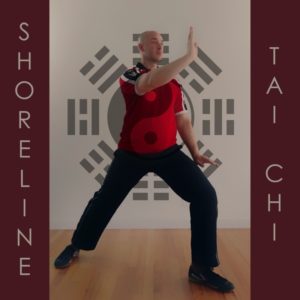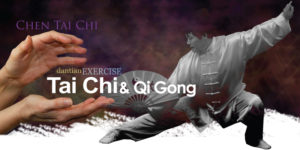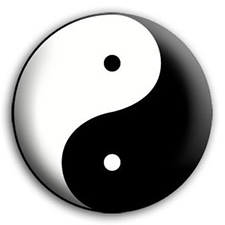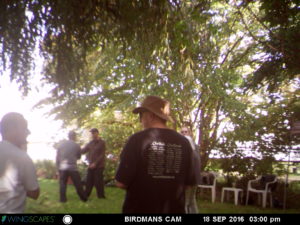Slanted FlyingJournal of Tai Chi Chuan
Training
Aligning With Gravity In Taijiquan
Springiness in the legs relies on both a downward sinking energy and a counteracting upward rising energy. It is like a ball or a boat floating on water that sinks part way into the water but is simultaneously buoyed up by the water. This is what the term chen (沉) refers to rather than the heaviness of zhong (重) which has only the downward component and is more analogous to bracing (i.e., only having heaviness pushing against the ground rather than including the springiness from the ground).
We have the ability, due to our flexible structure, to change forces from vertical to more horizontal when we issue force (especially by turning the waist while expressing energy through our arms) and from horizontal to more vertical when we receive forces. If we can redirect incoming forces more vertically into the ground, then an opponent is essentially pushing into the ground rather than to our rear. Then we can “load our springs” or “bows” (i.e. our legs).
A simple example of applying this “verticality” concept is seen when a practitioner places their hands underneath the elbows of a person trying to push them. Even without using much effort, the angles created by placing one’s hands under the pusher’s elbows changes where the force goes. The lifting up against the opponent’s elbows directs the incoming forces downward. Another example is when someone lowers their stance; especially if that gets their center of mass lower than that of their opponent, therefore imparting some verticality to the force coming from their opponent.
This principle of verticality ends in the legs/feet, but it involves many other parts of the body. It is connected to the “concave chest and lifted back” which helps to direct energy through the front of our torso and therefore into our legs (i.e. vertically) rather than to our backs (i.e. horizontally). Sinking the shoulders likewise directs energy down our torso. The same is true for sinking the elbows which also aids in directing forces more vertically rather than towards the back of the shoulders.
When one sticks their butt out, then forces “leak” out to the rear rather than into/from the legs. Likewise, if the pelvis is tucked too far, then the forces tend to be directed more to the knees and therefore “leak” forward. Maintaining a level pelvis aids the verticality of the forces into the legs and down to the feet/ground.
Shifting too far forward with the forward knee lets force “leak” forward rather than being directed down into the feet/ground. Locking the backward knee directs the force horizontally rather than downwards into the “springs” or “bows” of the legs. The locked knee acts like a brace and relies on tensing the structure to keep it in place. We instead want to have a structure that directs forces more vertically into the ground (our “root”) so that we can maintain our agility and changeability.
The more vertically forces are directed through our torso and into the ground through our legs/feet, the easier it is to maintain “central stability/equilibrium” (中定 zhong ding). When floating in water, we cannot produce as much force or be as agile as when we are standing on the ground. The ground provides the platform for generating our power as well as our mobility. The more vertically that we can direct forces from/to our feet and the ground, the less reliant we are on friction.
A sphere always maintains its center of mass above its base of support, and therefore cannot be tipped over, even though that base is only the small spot where the sphere touches the ground. Humans, however, are not spherical, and we often try to compensate for the vulnerability to being tipped over (losing one’s balance or “central equilibrium”) by taking a longer and/or wider stance to increase our base of support.
But if we can redirect incoming forces more vertically into our base of support, then a wide and/or long stance is not as necessary. A smaller base of support allows for greater mobility, and if practitioners can redirect incoming forces more vertically into their structure, then the more stabile they can be, even with a small base of support.
The legs generate power from the ground, and the more vertical this is the more stable and centered one is, even when one is in a fairly small stance with a small base of support. The waist gears that power into other planes of motion and the arms finish the expression of energy in any direction. But verticality is our primary source of power and this is illustrated by the observation that we can hold more weight above us (vertically) than we can handle from an angle to us.
Practitioners can practice their skill at issuing or receiving forces vertically from/into the ground during push-hands (推手 tui shou) practice by using a parallel stance (or even a one leg stance) [or while standing on bricks…]. Be careful not to resort to leaning on the training partner such that you would fall if they suddenly stepped away from you (breaking the engaged forces of your interactions).
We want a verticality of the spine; a stacking of the body; an alignment with gravity. This verticality should continue all the way down to the ground and therefore forces should also be directed vertically into our lower legs. The vertical forces are the strongest and most resistant to breaking. It is not vertical forces that break or topple trees, but shearing forces that hit the tree from the sides. The skill is in redirecting horizontal forces into vertical ones when defending, and issuing with horizontal power that originates vertically from the legs.
While a butting cow can produce powerful horizontal force, it is just using its mass, which is different than the trained force used in Taijiquan. I think that we train to act differently than we act instinctively, and we want to maximize the springs through our legs (or leg bows) rather than bracing (and tensing) to act horizontally.














Great post. Thanks!
good post. clear explanation
Good and clear of the supporting, acting and balancing forcies in oud bodies.
I just started studying Tai Chi 2 months ago, and I have no words to express how you clarified hard concepts like ground path and head top.
Thanks so much!
Great article, gravity is the start of everything